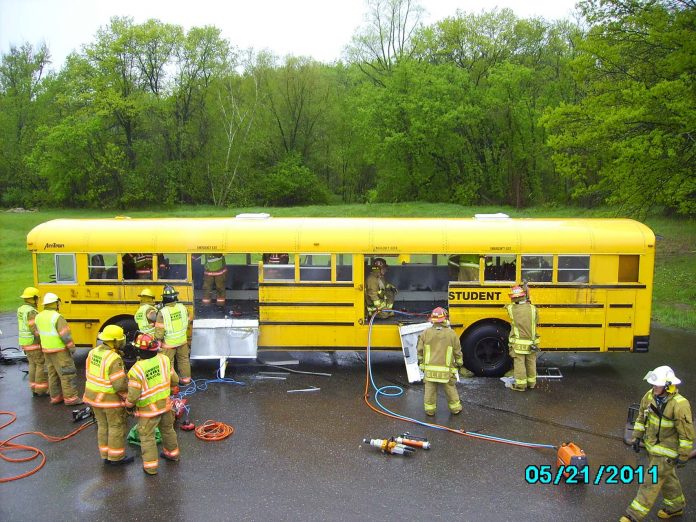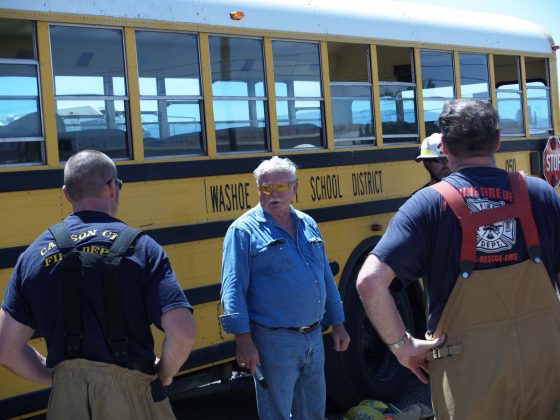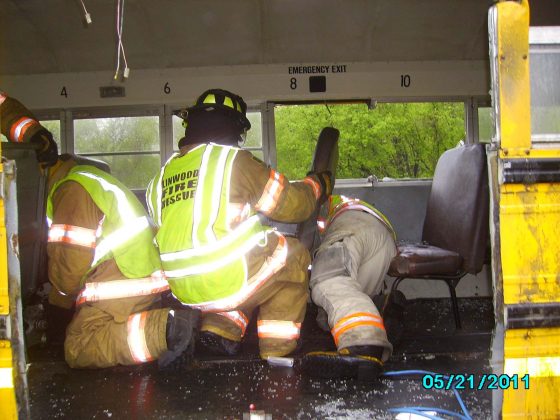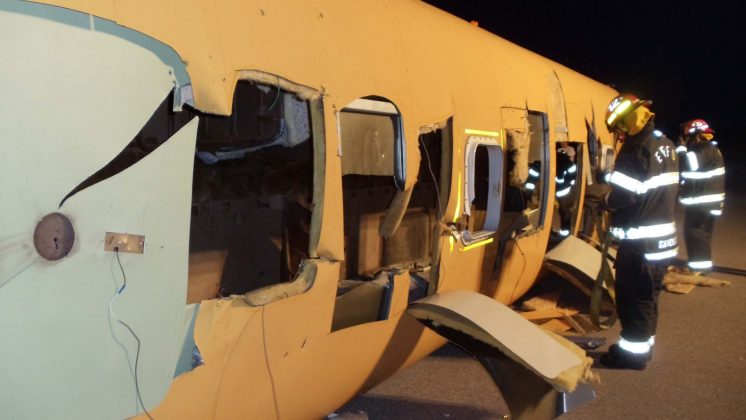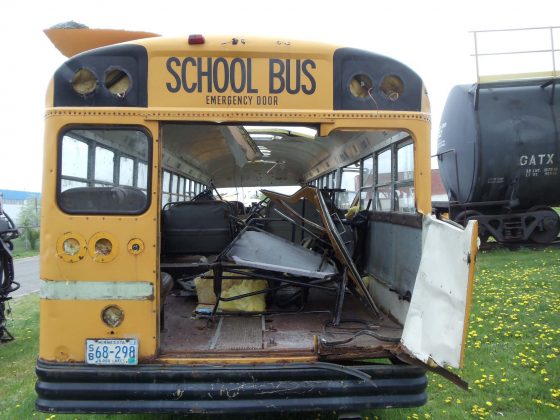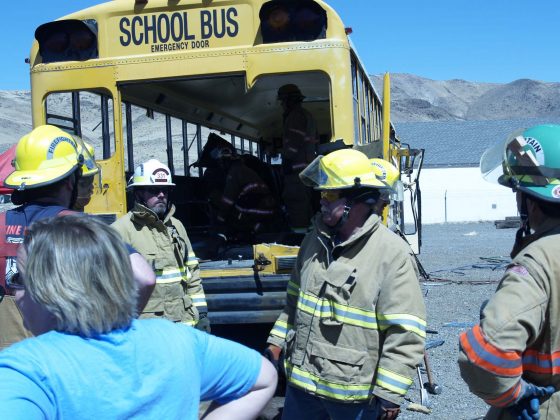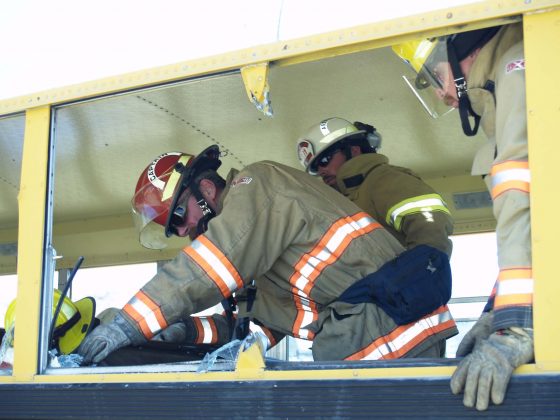In addition to training school bus drivers and students on potential emergencies that could occur while on the school bus, ensuring local first responders know the design of a school bus is just as critical.
But COVID-19 social distancing requirements have made that training harder to hold. A leading expert says it’s time student transporters refocus on conducting these exercises.
For example, a YouTube video that went viral this past year called attention to the black stripes, or rub rails, that run along the sides and back of a school bus. Their placement, from bottom to top, indicates the vehicle floor line and then the bottom and top of each bench seat on board, which gives firefighters an idea of where to cut in a crash, as certain areas of the bus are stronger than others.
Denny Coughlin, the owner of the School Bus Training, LLC, and a retired fleet manager for Minneapolis Public Schools, explained that the rub rails are not black in every state and are painted to provide contrast. He said when buses are impacted from the side, the rails consisting of corrugated metal are designed to transfer the crash force horizontally. Then, the roof bows effectively create a cage around the passenger compartment to further disperse the energy in a side-impact, protecting the integrity of the bus body from being crushed in most rollovers or other crashes.
Coughlin has been training fire departments regarding school bus crashes for the past 30 years and has torn apart around 200 buses as part of drills and exercises. He also frequently provides demonstrations to student transporters, like at the 2019 STN EXPO Reno, where he fogged a school bus with co-presenter Freddie Yazzie, a transportation worker from Ganado School District in Arizona, to simulate smoke from a school bus fire. The intent was to drill attendees on emergency evacuations.
Related: Back-to-School Driver, Attendant Training Helps to Save Lives
Related: Who Got Inspired by STN EXPO in Reno
Related: Student Transporters Share Keys to School Bus Crash Reporting, Documentation
In addition to the STN EXPO, Coughlin has performed demonstrations at national and state conferences as well as done a variety of drills for law enforcement and fire departments individually around the country. “School buses are unlike any other vehicle,” Coughlin said. “They have their own configurations as far as seat construction, for example.”
He added that he shows fire departments what happens to school buses in collisions, so they can better understand and prepare for what kind of injuries they should expect and how to best access the bus to extricate passengers or drivers. Coughlin explained that the angle of impact in a crash can greatly change the evacuation process and the potential injuries inside. For example, if the school bus was hit in the area of the entry door, evacuation would have to occur out the rear exit, which is something he demonstrates in drills.
Coughlin noted that because the bus aisle is only 12 inches wide, firefighters entering a school bus might have to remove seats to operate effectively and move quickly. Coughlin said he teaches first responders how to properly remove the seats as well as what to do with the seats, adding that sometimes firefighters need to be dropped out of the windows.
“I give them all of the methods that work best depending on the tools they have available,” he said.
If the driver is pinned behind the wheel, he teaches firefighters the best methods for extrication. This could consist of cutting out the steering wheel or pushing the dash forward. He noted these demonstrations with first responders are usually a day-long event that starts with a three-hour classroom instruction course.
“Sometimes we have students involved, or sometimes we don’t,” he said. “We’ve done exercises with as many as 50 or 60 kids inside that [firefighters] have to rescue first — students with different injuries, [even] some on the floor with back injuries which complicates things for [the first responders].”
Other conversations center around the basic construction of the bus, which includes topics such as the location of fuel tanks, how the bus body is attached to the chassis, and how and where to cut into the bus for the easiest entry. The main goal, Coughlin explained, is to help firefighters rescue students in the most reasonable and efficient method.
Coughlin added that he has also developed a program for law enforcement. He covers hijacking and hostage situations, training SWAT officers on the proper lines of fire and access points should they need to storm the bus.
Coughlin noted that most training offerings were put on hold when the pandemic hit, but 7 percent of 128 school districts responding to a recent School Transportation News survey said they continued to work with first responders on school bus mock causality drills despite COVID-19. Transportation directors across the nation shared in the April reader survey that they were able to donate school buses to first responders for smoke, fire and evacuation drills.
While teaching first responders the intricacies of a school bus is paramount, these safety experts can also teach school bus drivers life-saving techniques. [Article continues after the gallery.]
Photos courtesy of Denny Coughlin (middle) from his mock casualty training sessions with first responders through the years.
Beaufort County School District in South Carolina welcomes first responders into its transportation facility to train its drivers on active shooting scenarios and the “Stop the Bleed” program, which is a national campaign focused on teaching how to stop a severely injured person from bleeding.
Transportation Director Eldridge Black, Jr., said in his two years at Beaufort he’s had fire departments give presentations to the drivers, which includes information on first-aid training and using the defibrillator.
The local sheriff’s office also visited the transportation facility to demonstrate an active shooter scenario. Currently, Black said he’s working with law enforcement on using school buses as emergency evacuation vehicles, to prepare for a potential incident occurring in the community or at a school building.
He added Beaufort County recently purchased a radio system that has access to the police department’s channels, so transportation can monitor in real time what is happening locally. This, he said, benefited the district. For example, he learned of emergency personnel responding to a gas leak at one of the high schools. Black said he was able to spring his driving staff into action and safely evacuate and transport all the students home.


